Teenage Mutant Ninja Turtles, commonly abbreviated as TMNT, is a media franchise created by the comic book artists Kevin Eastman and Peter Laird. It follows Leonardo, Donatello, Raphael and Michelangelo, four anthropomorphic turtle brothers trained in ninjutsu who fight evil in New York City. The franchise encompasses printed media, television series', feature films, video games, and merchandise.

Donatello, nicknamed Donnie, is a superhero and one of the four main characters of the Teenage Mutant Ninja Turtles comics and all related media. He is the smartest and often gentlest of his brothers, wearing a purple mask over his eyes. He wields a bō staff, his primary signature weapon in all media.

Raphael, nicknamed Raph, is a superhero and one of the four main characters of the Teenage Mutant Ninja Turtles comics and all related media. In most iterations, he is depicted as the most aggressive of the turtle brothers, physically the strongest, and often at odds with his brother, Leonardo.

Teenage Mutant Ninja Turtles: Turtles in Time, released as Teenage Mutant Hero Turtles: Turtles in Time in Europe, is a 1991 beat 'em up game developed and published by Konami for arcades. A sequel to the original Teenage Mutant Ninja Turtles arcade game, it is a side-scrolling game based mainly on the 1987 TMNT animated series. Originally an arcade game, Turtles in Time was ported to the Super Nintendo Entertainment System in 1992 under the title Teenage Mutant Ninja Turtles IV: Turtles in Time, continuing the numbering from the earlier Turtles games released on the original NES. That same year, a game that borrowed many elements, Teenage Mutant Ninja Turtles: The Hyperstone Heist, was released for the Sega Genesis.
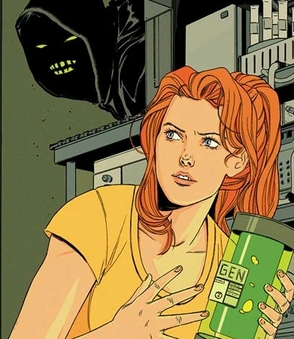
April O'Neil is a fictional character from the Teenage Mutant Ninja Turtles comics. She is the first human ally of the Ninja Turtles.

Teenage Mutant Ninja Turtles & Other Strangeness is a role-playing game based on the comic book created by Kevin Eastman and Peter Laird. The core rulebook was first published by Palladium Books in September 1985 – before the Turtles franchise achieved mass popularity – and featured original comic strips and illustrations by Eastman and Laird. The rules and gameplay are based on Palladium's Megaversal system.
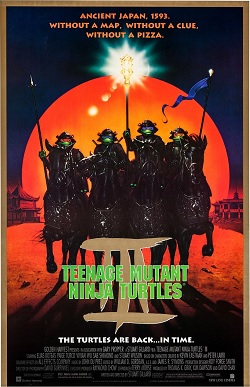
Teenage Mutant Ninja Turtles III is a 1993 American superhero film based on the Teenage Mutant Ninja Turtles characters created by Kevin Eastman and Peter Laird. Written and directed by Stuart Gillard, it is the sequel to Teenage Mutant Ninja Turtles (1990) and Teenage Mutant Ninja Turtles II: The Secret of the Ooze (1991), and the third installment in the original Turtles film trilogy. It stars Elias Koteas, Paige Turco, Vivian Wu, Sab Shimono, and Stuart Wilson with the voices of Brian Tochi, Robbie Rist, Corey Feldman, and Tim Kelleher. The plot revolves around the "Sacred Sands of Time", a mystical scepter which transports the Turtles and April back in time to feudal Japan, where they become embroiled in a conflict between a daimyō and a group of rebellious villagers.

Bebop and Rocksteady are a fictional duo of a mutant warthog and mutant rhinoceros that have made appearances as characters in various media releases of the Teenage Mutant Ninja Turtles franchise. The two characters are henchmen who follow the orders of the franchise's chief antagonist, Shredder, the leader of the Foot Clan. Their names are both derived from genres of music: Bebop is a style of jazz, while Rocksteady is a Jamaican music style, a precursor to reggae.

Karai is a fictional supporting character appearing in Teenage Mutant Ninja Turtles comics and related media. She is usually a high-rank member of the Foot Clan outlaw ninja organization. She was introduced in Kevin Eastman and Peter Laird's comic book series Teenage Mutant Ninja Turtles in 1992. Since then, she has appeared in several different Teenage Mutant Ninja Turtles comics, television series, films, and video games. She is depicted as Shredder's second-in-command or adopted daughter in most versions and shares a rivalry with Leonardo and is at times considered his love interest. In one version of the comics, she is the granddaughter of the immortal Shredder, while in the 2012 series, she is Hamato Miwa, the only child of Hamato "Splinter" Yoshi and the late Tang Shen.

Venus de Milo is a fictional superheroine within the Teenage Mutant Ninja Turtles franchise. She first appeared in the television series, Ninja Turtles: The Next Mutation. There, she was portrayed by Nicole Parker and voiced by Lalainia Lindbjerg. She was the only female turtle prior to the introduction of Jennika in the IDW continuity in 2015, and Lita the following year. Venus is currently the only turtle named after a work of art, rather than an artist like the rest of the turtles.
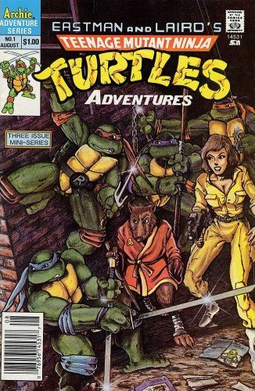
Teenage Mutant Ninja Turtles Adventures is an American comic book series that was published from August 1988 to October 1995 by Archie Comics. The series, which was aimed at a younger audience than other Teenage Mutant Ninja Turtles comics at the time, ran for 72 issues. In addition, there were numerous annuals, specials, and miniseries.

Teenage Mutant Ninja Turtles (TMNT) is a comic book series that was published by Mirage Studios between 1984 and 2014. Conceived by Kevin Eastman and Peter Laird, it was initially intended as a one-shot, but due to its popularity it became an ongoing series. The comic created the Turtles franchise of five television series, seven feature films, numerous video games, and a range of toys and merchandise.

Action figures based on the Teenage Mutant Ninja Turtles franchise have been produced by Playmates Toys since 1988. Staff artists at the Northampton, Massachusetts based Mirage Studios have provided conceptual designs for many of the figures, vehicles, and playsets and are credited on the packaging of the products they created.
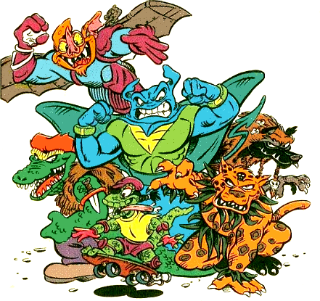
Mighty Mutanimals, a superhero group within the Teenage Mutant Ninja Turtles (TMNT) franchise, emerged in the comic book series Teenage Mutant Ninja Turtles Adventures. Composed of various mutated animals, the team collaborated with the TMNT and has been featured in multiple iterations of the franchise since its inception.
The Teenage Mutant Ninja Turtles, a superhero team created by Kevin Eastman and Peter Laird, have appeared in seven theatrical feature-length films since their debut. The first film was released in 1990, at the height of the franchise's popularity. Despite mixed reviews from critics, it was a commercial success that garnered two direct sequels, Teenage Mutant Ninja Turtles II: The Secret of the Ooze in 1991 and Teenage Mutant Ninja Turtles III in 1993, both of which were modest successes. An animated film titled TMNT was released in 2007.
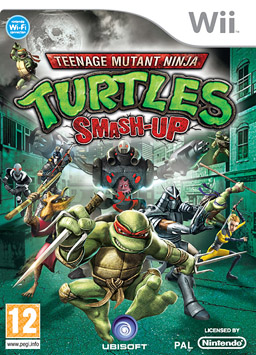
Teenage Mutant Ninja Turtles: Smash-Up is a 2.5D fighting game for the Wii and PlayStation 2 video game consoles featuring characters from the Teenage Mutant Ninja Turtles franchise. It was co-developed by Game Arts, Toylogic, and Y's K, and released by Ubisoft in September 2009 in celebration of the TMNT franchise's 25th anniversary.
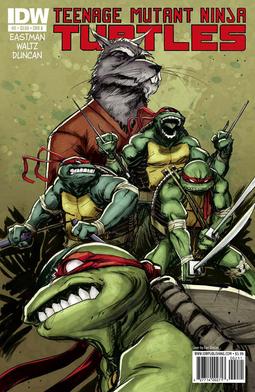
Teenage Mutant Ninja Turtles is an ongoing American comic book series published by IDW Publishing. Debuting in August 2011, the series is part of the Teenage Mutant Ninja Turtles media franchise created by Kevin Eastman and Peter Laird and was the first new comic incarnation of the Turtles to debut after the franchise's sale to Nickelodeon in October 2009. It is the fifth comic book series in the franchise's publication history and serves as a reboot of the franchise's story and characters, including those originating in media from outside the original Mirage comics.
Teenage Mutant Ninja Turtles is an American animated television series developed by Ciro Nieli, Joshua Sternin, and Jennifer Ventimilia for Nickelodeon, based on the characters created by Kevin Eastman and Peter Laird. The series begins with the Turtles emerging from their sewer home for the first time, using their ninjutsu training to fight enemies in present-day New York City. The series ran in the United States from September 28, 2012, to November 12, 2017.

Teenage Mutant Ninja Turtles: Mutants in Manhattan is a 2016 hack and slash game developed by PlatinumGames and published by Activision. It is inspired by IDW Publishing's Teenage Mutant Ninja Turtles comic book series. It was released for PlayStation 3, PlayStation 4, Windows, Xbox 360, and Xbox One in May 2016. Less than eight months after its release, the game was removed from sale from all digital storefronts on January 3, 2017. This was the last Nickelodeon game to be published by Activision, with the rights for the Teenage Mutant Ninja Turtles video game series being given to Dotemu.















